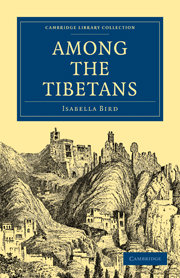CHAPTER V - CLIMATE AND NATURAL FEATURES
Published online by Cambridge University Press: 29 August 2010
Summary
The last chapter left me with the chief and elders of the Chang-pas starting on ‘a round of visits,’ and it was not till nightfall that the solemn ceremony was concluded. Each of the fifty tents was visited: at every one a huge, savage Tibetan mastiff made an attempt to fly at me, and was pounced upon and held down by a woman little bigger than himself, and in each cheese and milk were offered and refused. In all I received a hearty welcome for the sake of the ‘great father,’ Mr. Redslob, who designated these people as ‘the simplest and kindliest people on earth.
This Chang-pa tribe, numbering five hundred souls, makes four moves in the year, dividing in summer, and uniting in a valley very free from snow in the winter. They are an exclusively pastoral people, and possess large herds of yaks and ponies and immense flocks of sheep and goats, the latter almost entirely the beautiful ‘shawl goat,’ from the undergrowth at the base of the long hair of which the fine Kashmir shawls are made. This pashm is a provision which Nature makes against the intense cold of these altitudes, and grows on yaks, sheep, and dogs, as well as on most of the wild animals. The sheep is the big, hornless, flop-eared huniya. The yaks and sheep are the load carriers of Rupchu. Small or easily divided merchandise is carried by sheep, and bulkier goods by yaks, and the Chang-pas make a great deal of money by carrying for the Lahul, Central Ladak, and Rudok merchants, their sheep travelling as far as Gar in Chinese Tibet.
- Type
- Chapter
- Information
- Among the Tibetans , pp. 130 - 159Publisher: Cambridge University PressPrint publication year: 2010First published in: 1894

